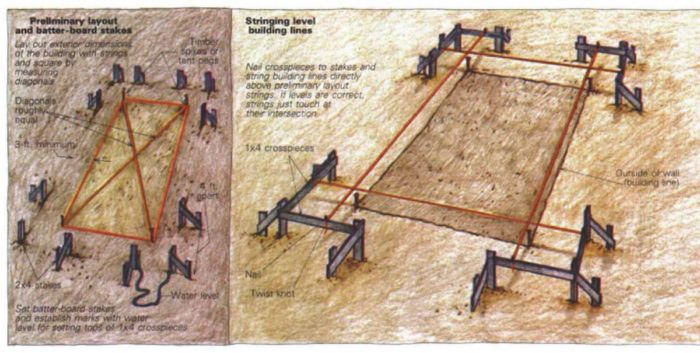Site Layout
On a flat lot, footings can be oriented with precision using batter boards, string and a water level.

Synopsis: The author explains the process of laying out a foundation with string lines and batter boards. The house is a simple rectangle, but the principles are universal. Clear illustrations help.
Driving that first stake is always exciting. It doesn’t matter whether you’ve been designing and dreaming about the house for years, or you’re beginning the first day of actual work on what you hope will be a profitable contract. Laying out the site in preparation for foundation work is your first chance to visualize the house full scale in its setting. The accuracy of your layout and the foundation it defines will also determine how much you will have to struggle to make your house tight and square.
Unless you are building on a sloped site, all you will need to do the job right is a 100-ft. tape measure, a water level, a ball of nylon string, enough lumber for batter boards, a helper and the application of some practical geometry.
Let’s assume that the house is a simple rectangle, and that one of the long walls faces south. If precise solar orientation is important, use a compass or one of the many commercially available siting devices. If such precision is unnecessary, stand facing the midday sun. Your outstretched left arm will point to the east and your right arm to the west. Unroll a ball of string along this axis for a distance a few feet greater than one of the long walls of your building. I use braided nylon string because it will take an awesome amount of tension before it breaks, and because braided string doesn’t unravel and can be used indefinitely. It comes in a highly visible yellow as well as in white.
Preliminary layout
Select one end of the layout as a starting corner and drive a small stake into the ground. You can use almost anything for a stake — a timber spike or a tent peg — as long as it holds the string off the ground. Now measure back down the string the length of the wall, drive another stake, stretch the string between the two stakes and tie it off. This lets you adjust the placement of the house on the site, and gives you an idea of where to locate the batter boards. Taut strings and accurate squaring are not necessary at this point, as long as the outside dimensions of the house are accurate.
To lay out the rectangle, pull another string from the corner you just established, at a right angle to the long wall. This is where your helper is needed. One person pulls the string while the other guesses at 90°. Measure along this second string the width of the house and drive the third corner stake. The fourth corner can be found by measuring. Now step back and study the house placement on the site. Stop and think on this one a while — it’s a permanent decision. If you are satisfied, you can begin preliminary squaring.
For more illustrations and details, click the View PDF button below:
Fine Homebuilding Recommended Products
Fine Homebuilding receives a commission for items purchased through links on this site, including Amazon Associates and other affiliate advertising programs.

Code Check 10th Edition: An Illustrated Guide to Building a Safe House

Plate Level

All New Bathroom Ideas that Work


























